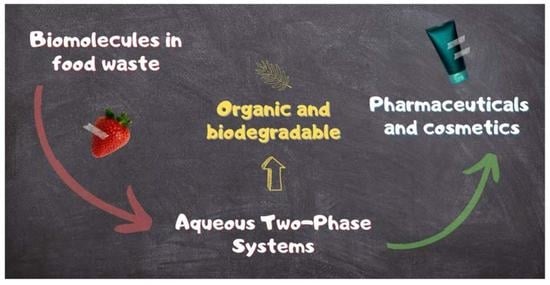Extraction of Polyphenols and Vitamins Using Biodegradable ATPS Based on Ethyl Lactate
Abstract
1. Introduction
2. Materials and Methods
2.1. Chemicals
2.2. Apparatus and Experimental Procedure
2.2.1. Influence of System’s pH in the UV–Vis Absorbance Spectra
2.2.2. UV–Vis Absorbance Calibration Curves
2.2.3. Liquid–Liquid Extraction of Biomolecules
3. Results and Discussion
3.1. Influence of pH in the UV–Vis Absorbance Spectra
3.2. UV–Vis Absorbance Calibration Curves
3.3. Partitioning of Biomolecules
3.4. Mass Balance
4. Conclusions
Supplementary Materials
Author Contributions
Funding
Institutional Review Board Statement
Informed Consent Statement
Data Availability Statement
Acknowledgments
Conflicts of Interest
References
- Eičaitė, O.; Baležentis, T.; Ribašauskienė, E.; Morkūnas, M.; Melnikienė, R.; Štreimikienė, D. Food waste in the retail sector: A survey-based evidence from Central and Eastern Europe. J. Retail. Consum. Serv. 2022, 69, 103116. [Google Scholar] [CrossRef]
- Ananda, J.; Karunasena, G.G.; Pearson, D. Identifying interventions to reduce household food waste based on food categories. Food Policy 2022, 111, 102324. [Google Scholar] [CrossRef]
- Siddiqui, Z.; Hagare, D.; Jayasena, V.; Swick, R.; Rahman, M.M.; Boyle, N.; Ghodrat, M. Recycling of food waste to produce chicken feed and liquid fertiliser. Waste Manag. 2021, 131, 386–393. [Google Scholar] [CrossRef] [PubMed]
- Ojha, S.; Bußler, S.; Schlüter, O.K. Food waste valorisation and circular economy concepts in insect production and processing. Waste Manag. 2020, 118, 600–609. [Google Scholar] [CrossRef] [PubMed]
- Caldeira, C.; Vlysidis, A.; Fiore, G.; De Laurentiis, V.; Vignali, G.; Sala, S. Sustainability of food waste biorefinery: A review on valorisation pathways, techno-economic constraints, and environmental assessment. Bioresour. Technol. 2020, 312, 123575. [Google Scholar] [CrossRef]
- Tournour, H.H.; Segundo, M.A.; Magalhães, L.M.; Barreiros, L.; Queiroz, J.; Cunha, L. Valorization of grape pomace: Extraction of bioactive phenolics with antioxidant properties. Ind. Crop. Prod. 2015, 74, 397–406. [Google Scholar] [CrossRef]
- Ferreira, S.M.; Santos, L. From by-product to functional ingredient: Incorporation of avocado peel extract as an antioxidant and antibacterial agent. Innov. Food Sci. Emerg. Technol. 2022, 80, 103116. [Google Scholar] [CrossRef]
- Tavares, L.; Smaoui, S.; Lima, P.S.; de Oliveira, M.M.; Santos, L. Propolis: Encapsulation and application in the food and pharma-ceutical industries. Trends Food Sci. Technol. 2022, 127, 169–180. [Google Scholar] [CrossRef]
- Hatti-Kaul, R. Aqueous Two-Phase Systems: A General Overview. Mol. Biotechnol. 2001, 19, 269–278. [Google Scholar] [CrossRef]
- Saha, N.; Sarkar, B.; Sen, K. Aqueous biphasic systems: A robust platform for green extraction of biomolecules. J. Mol. Liq. 2022, 363, 119882. [Google Scholar] [CrossRef]
- Wysoczanska, K.; Macedo, E.A. Influence of the Molecular Weight of PEG on the Polymer/Salt Phase Diagrams of Aqueous Two-Phase Systems. J. Chem. Eng. Data 2016, 61, 4229–4235. [Google Scholar] [CrossRef]
- Wysoczanska, K.; Do, H.T.; Held, C.; Sadowski, G.; Macedo, E.A. Effect of different organic salts on amino acids partition behaviour in PEG-salt ATPS. Fluid Phase Equilibria 2018, 456, 84–91. [Google Scholar] [CrossRef]
- Gomes, G.A.; Azevedo, A.M.; Aires-Barros, M.R.; Prazeres, D.M.F. Purification of plasmid DNA with aqueous two phase systems of PEG 600 and sodium citrate/ammonium sulfate. Sep. Purif. Technol. 2009, 65, 22–30. [Google Scholar] [CrossRef]
- Panas, P.; Lopes, C.; Cerri, M.O.; Ventura, S.P.; Santos-Ebinuma, V.C.; Pereira, J.F. Purification of clavulanic acid produced by Streptomyces clavuligerus via submerged fermentation using polyethylene glycol/cholinium chloride aqueous two-phase systems. Fluid Phase Equilibria 2017, 450, 42–50. [Google Scholar] [CrossRef]
- Liu, C.; Liu, S.; Zhang, L.; Wang, X.; Ma, L. Partition Behavior in Aqueous Two-Phase System and Antioxidant Activity of Flavonoids from Ginkgo biloba. Appl. Sci. 2018, 8, 2058. [Google Scholar] [CrossRef]
- Nascimento, K.S.; Rosa, P.; Cavada, B.; Azevedo, A.M.; Aires-Barros, M.R. Partitioning and recovery of Canavalia brasiliensis lectin by aqueous two-phase systems using design of experiments methodology. Sep. Purif. Technol. 2010, 75, 48–54. [Google Scholar] [CrossRef]
- Dolzhenko, A.V. Ethyl lactate and its aqueous solutions as sustainable media for organic synthesis. Sustain. Chem. Pharm. 2020, 18, 100322. [Google Scholar] [CrossRef]
- Dandia, A.; Jain, A.K.; Laxkar, A.K. Ethyl lactate as a promising bio based green solvent for the synthesis of spiro-oxindole derivatives via 1,3-dipolar cycloaddition reaction. Tetrahedron Lett. 2013, 54, 3929–3932. [Google Scholar] [CrossRef]
- Pereira, C.; Silva, V.M.T.M.; Rodrigues, A.E. Fixed Bed Adsorptive Reactor for Ethyl Lactate Synthesis: Experiments, Modelling, and Simulation. Sep. Sci. Technol. 2009, 44, 2721–2749. [Google Scholar] [CrossRef]
- Pereira, C.; Zabka, M.; Silva, V.M.; Rodrigues, A.E. A novel process for the ethyl lactate synthesis in a simulated moving bed reactor (SMBR). Chem. Eng. Sci. 2009, 64, 3301–3310. [Google Scholar] [CrossRef]
- Velho, P.; Oliveira, I.; Gómez, E.; Macedo, E.A. pH Study and Partition of Riboflavin in an Ethyl Lactate-Based Aqueous Two-Phase System with Sodium Citrate. J. Chem. Eng. Data 2022, 67, 1985–1993. [Google Scholar] [CrossRef]
- Kua, Y.L.; Gan, S.; Morris, A.; Ng, H.K. Optimization of simultaneous carotenes and vitamin E (tocols) extraction from crude palm olein using response surface methodology. Chem. Eng. Commun. 2018, 205, 596–609. [Google Scholar] [CrossRef]
- Ishida, B.K.; Chapman, M.H. Carotenoid Extraction from Plants Using a Novel, Environmentally Friendly Solvent. J. Agric. Food Chem. 2009, 57, 1051–1059. [Google Scholar] [CrossRef]
- Velho, P.; Requejo, P.F.; Gómez, E.; Macedo, E.A. Novel ethyl lactate based ATPS for the purification of rutin and quercetin. Sep. Purif. Technol. 2020, 252, 117447. [Google Scholar] [CrossRef]
- Requejo, P.F.; Velho, P.; Gómez, E.; Macedo, E.A. Study of Liquid–Liquid Equilibrium of Aqueous Two-Phase Systems Based on Ethyl Lactate and Partitioning of Rutin and Quercetin. Ind. Eng. Chem. Res. 2020, 59, 21196–21204. [Google Scholar] [CrossRef]
- Lores, M.; Pájaro, M.; Álvarez-Casas, M.; Domínguez, J.; García-Jares, C. Use of ethyl lactate to extract bioactive compounds from Cytisus scoparius: Comparison of pressurized liquid extraction and medium scale ambient temperature systems. Talanta 2015, 140, 134–142. [Google Scholar] [CrossRef]
- Kamalanathan, I.; Canal, L.; Hegarty, J.; Najdanovic-Visak, V. Partitioning of amino acids in the novel biphasic systems based on environmentally friendly ethyl lactate. Fluid Phase Equilibria 2018, 462, 6–13. [Google Scholar] [CrossRef]
- Datta, S.; Bals, B.; Lin, Y.J.; Negri, M.; Datta, R.; Pasieta, L.; Ahmad, S.F.; Moradia, A.A.; Dale, B.; Snyder, S.W. An attempt towards simultaneous biobased solvent based extraction of proteins and enzymatic saccharification of cellulosic materials from distiller’s grains and solubles. Bioresour. Technol. 2010, 101, 5444–5448. [Google Scholar] [CrossRef]
- Zakrzewska, M.E.; Nunes, A.V.; Barot, A.R.; Fernández-Castané, A.; Visak, Z.P.; Kiatkittipong, W.; Najdanovic-Visak, V. Extraction of antibiotics using aqueous two-phase systems based on ethyl lactate and thiosulphate salts. Fluid Phase Equilibria 2021, 539, 113022. [Google Scholar] [CrossRef]
- Velho, P.; Gómez, E.; Macedo, E.A. Calculating the closest approach parameter for ethyl lactate-based ATPS. Fluid Phase Equilibria 2022, 556, 113389. [Google Scholar] [CrossRef]
- Wu, X.; Li, R.; Zhao, Y.; Liu, Y. Separation of polysaccharides from Spirulina platensis by HSCCC with ethanol-ammonium sulfate ATPS and their antioxidant activities. Carbohydr. Polym. 2017, 173, 465–472. [Google Scholar] [CrossRef] [PubMed]
- Velho, P.; Requejo, P.F.; Gómez, E.; Macedo, E.A. Thermodynamic study of ATPS involving ethyl lactate and different inorganic salts. Sep. Purif. Technol. 2021, 275, 119155. [Google Scholar] [CrossRef]
- Li, Z.; Feng, Y.; Liu, X.; Wang, H.; Pei, Y.; Gunaratne, H.Q.N.; Wang, J. Light-Triggered Switchable Ionic Liquid Aqueous Two-Phase Systems. ACS Sustain. Chem. Eng. 2020, 8, 15327–15335. [Google Scholar] [CrossRef]
- Requejo, P.F.; Gómez, E.; Macedo, E.A. Partitioning of DNP-Amino Acids in New Biodegradable Choline Amino Acid/Ionic Liquid-Based Aqueous Two-Phase Systems. J. Chem. Eng. Data 2019, 64, 4733–4740. [Google Scholar] [CrossRef]
- Amid, M.; Manap, M.Y.; Hussin, M.; Mustafa, S. A Novel Aqueous Two Phase System Composed of Surfactant and Xylitol for the Purification of Lipase from Pumpkin (Cucurbita moschata) Seed sand Recycling of Phase Components. Molecules 2015, 20, 11184–11201. [Google Scholar] [CrossRef]
- Panche, A.N.; Diwan, A.D.; Chandra, S.R. Flavonoids: An overview. J. Nutr. Sci. 2016, 5, e47. [Google Scholar] [CrossRef] [PubMed]
- Dias, T.; Silva, M.R.; Damiani, C.; da Silva, F.A. Quantification of Catechin and Epicatechin in Foods by Enzymatic-Spectrophotometric Method with Tyrosinase. Food Anal. Methods 2017, 10, 3914–3923. [Google Scholar] [CrossRef]
- Tsanova-Savova, S.; Ribarova, F.; Gerova, M. (+)-Catechin and (−)-epicatechin in Bulgarian fruits. J. Food Compos. Anal. 2005, 18, 691–698. [Google Scholar] [CrossRef]
- Jiménez, R.; Duarte, J.; Perez-Vizcaino, F. Epicatechin: Endothelial Function and Blood Pressure. J. Agric. Food Chem. 2012, 60, 8823–8830. [Google Scholar] [CrossRef]
- Haskell-Ramsay, C.F.; Schmitt, J.; Actis-Goretta, L. The Impact of Epicatechin on Human Cognition: The Role of Cerebral Blood Flow. Nutrients 2018, 10, 986. [Google Scholar] [CrossRef]
- Banjari, I.; Hjartåker, A. Dietary sources of iron and vitamin B12: Is this the missing link in colorectal carcinogenesis? Med. Hypotheses 2018, 116, 105–110. [Google Scholar] [CrossRef]
- Green, R.; Allen, L.H.; Bjørke-Monsen, A.-L.; Brito, A.; Guéant, J.-L.; Miller, J.W.; Molloy, A.M.; Nexo, E.; Stabler, S.; Toh, B.-H.; et al. Vitamin B12 deficiency. Nat. Rev. Dis. Primers 2017, 3, 17040. [Google Scholar] [CrossRef] [PubMed]
- Bodor, E.T.; Offermanns, S. Nicotinic acid: An old drug with a promising future. J. Cereb. Blood Flow Metab. 2008, 153, S68–S75. [Google Scholar] [CrossRef] [PubMed]
- Çat, J.; Yaman, M. Determination of Nicotinic Acid and Nicotinamide Forms of Vitamin B3 (Niacin) in Fruits and Vegetables by HPLC Using Postcolumn Derivatization System. Pak. J. Nutr. 2019, 18, 563–570. [Google Scholar] [CrossRef][Green Version]
- Kennedy, J.; Munro, M.; Powell, H.; Porter, L.; Foo, L. The protonation reactions of catechin, epicatechin and related compounds. Aust. J. Chem. 1984, 37, 885–892. [Google Scholar] [CrossRef]
- Brodie, J.D.; Poe, M. Proton magnetic resonance of vitamin B12 derivatives. Functioning of B12 coenzymes. Biochemistry 1972, 11, 2534–2542. [Google Scholar] [CrossRef] [PubMed]
- Evans, R.F.; Herington, E.F.G.; Kynaston, W. Determination of dissociation constants of the pyridine-monocarboxylic acids by ultra-violet photoelectric spectrophotometry. Trans. Faraday Soc. 1953, 49, 1284–1292. [Google Scholar] [CrossRef]

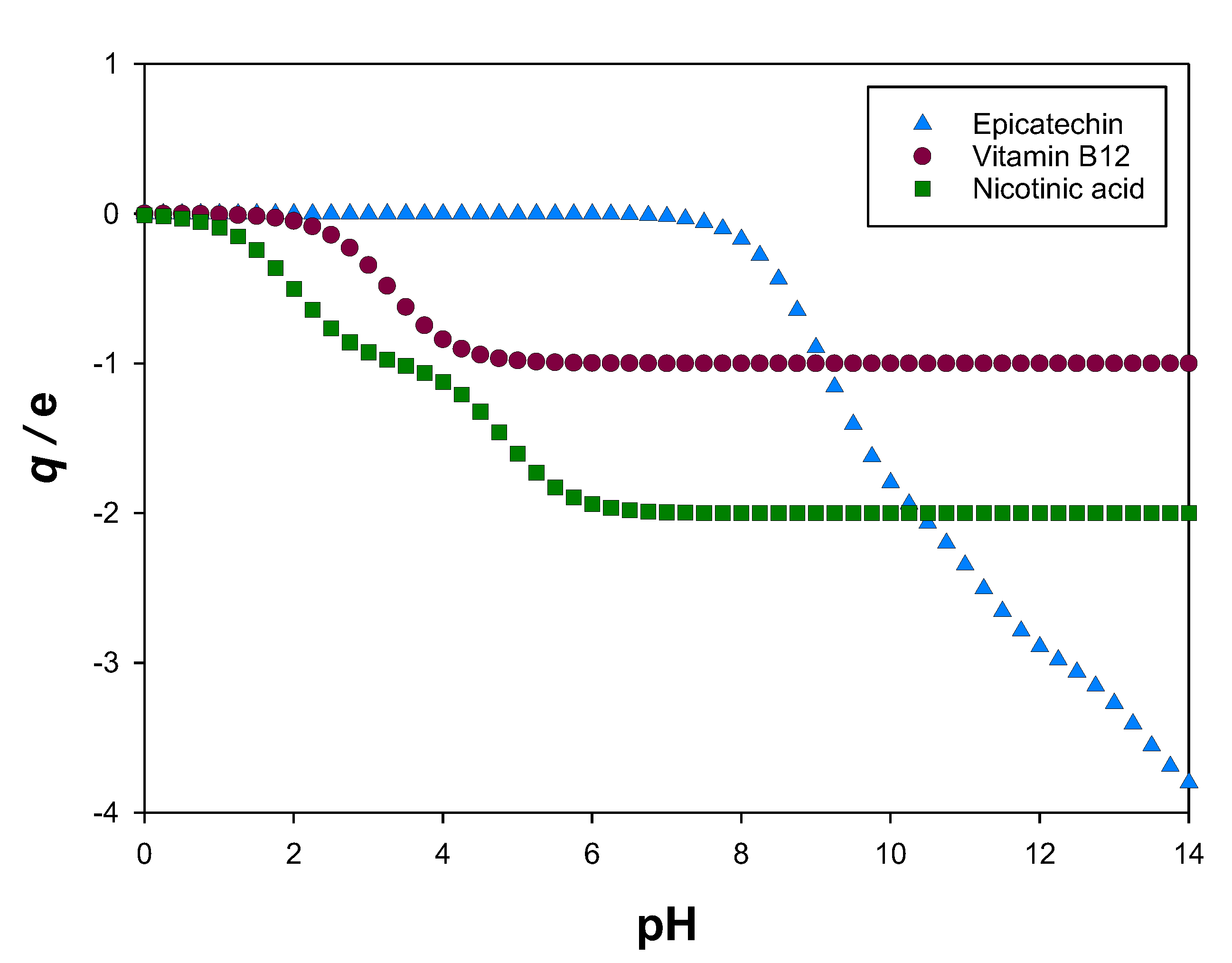

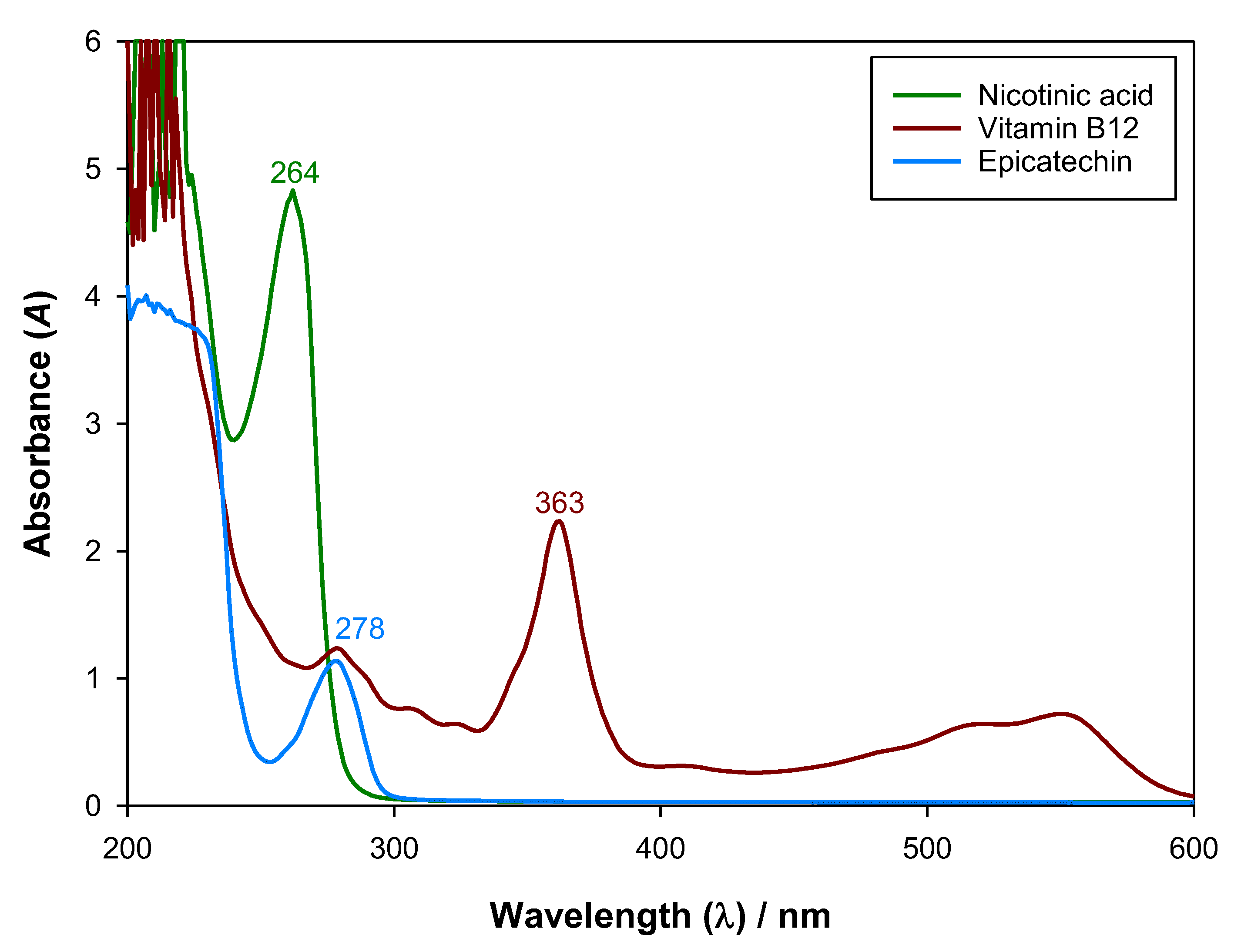
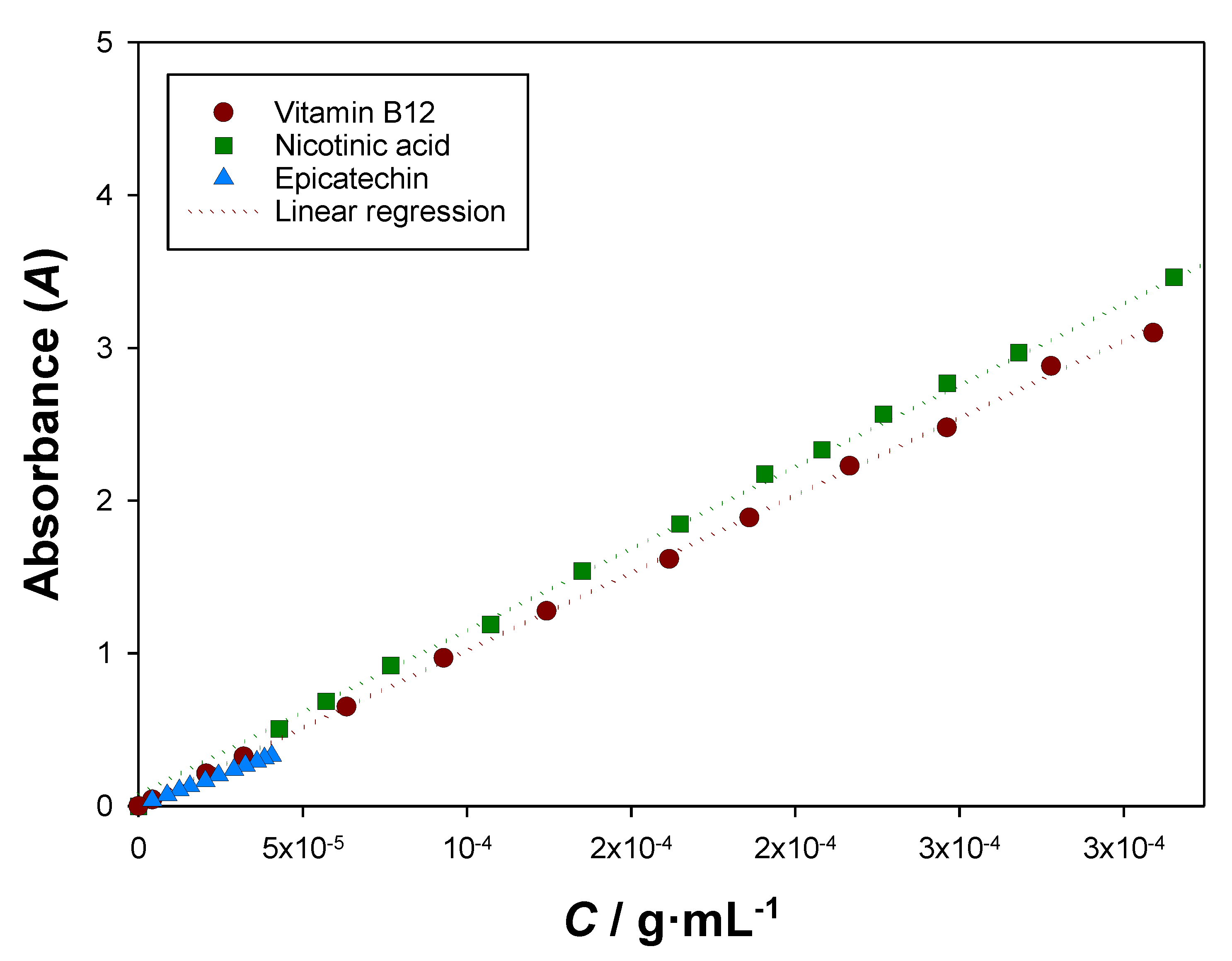
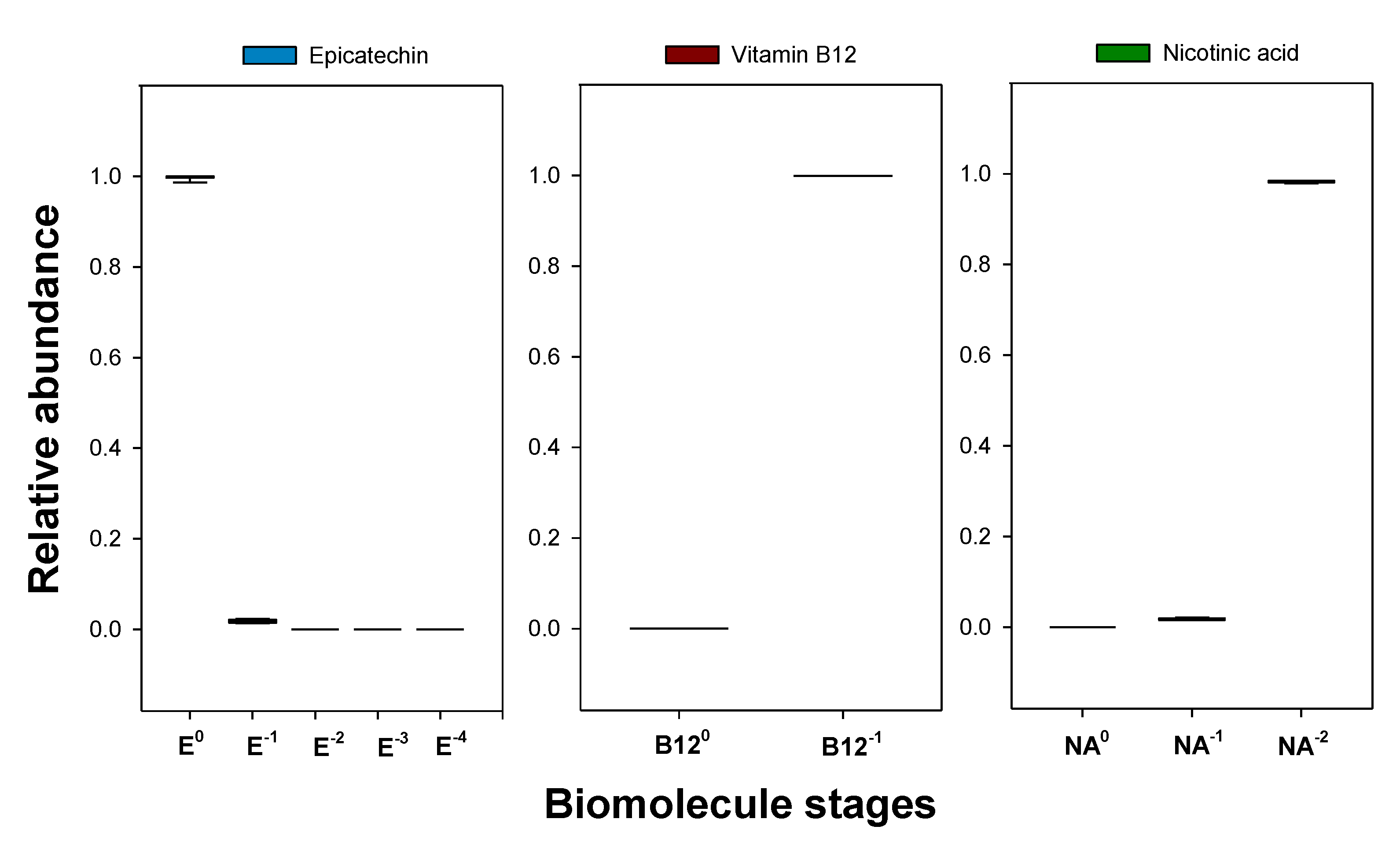

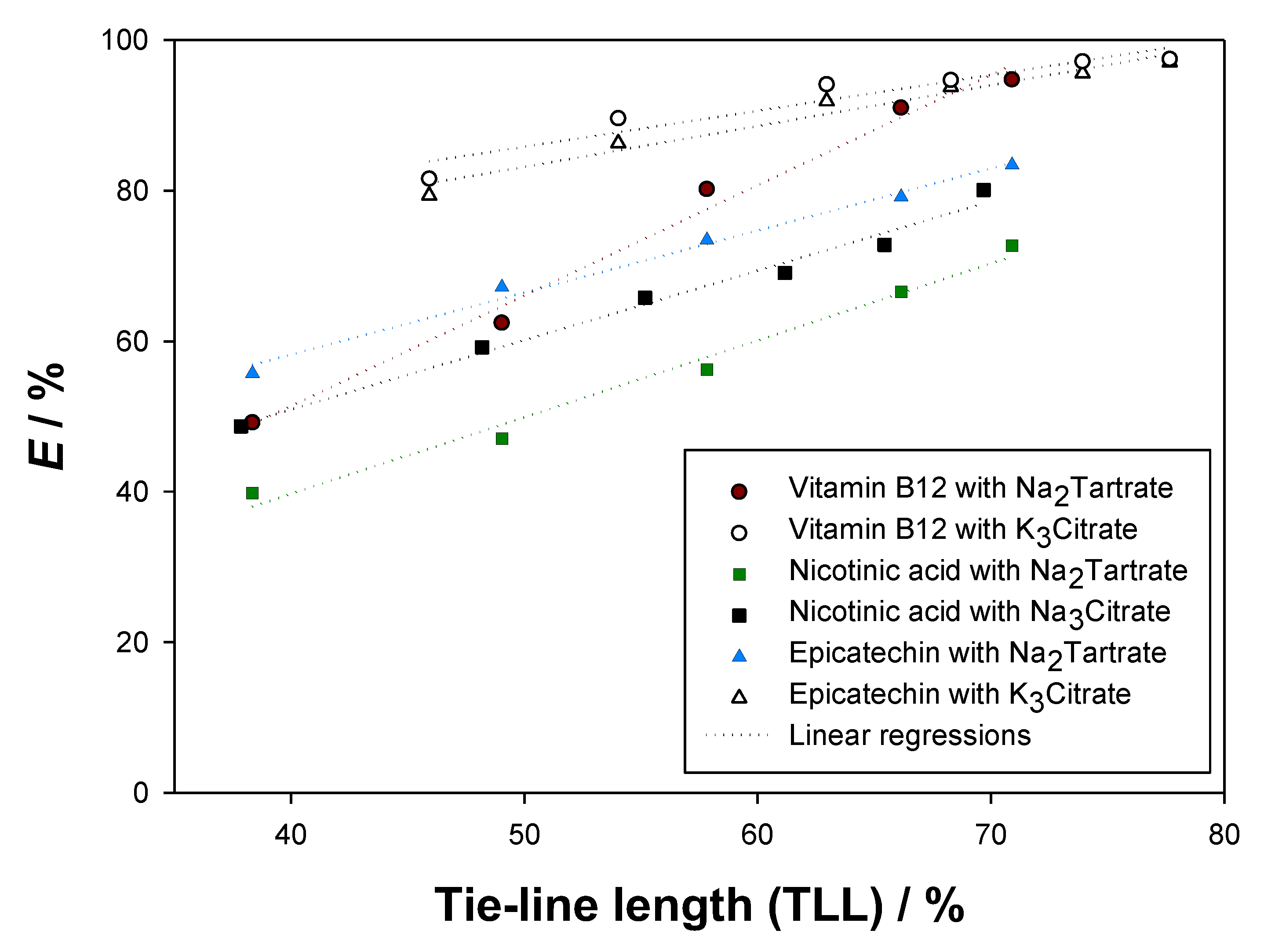
| Chemical | Supplier | Purity a/m% b | CAS | Abbreviation |
|---|---|---|---|---|
| Acetic acid (CH3COOH) | Merck | >99.8 | 64-19-7 | - |
| Cyanocobalamin or vitamin B12 (C63H88CoN14O14P) | Sigma-Aldrich | >98 | 68-19-9 | B12 |
| (-)-epicatechin (C15H14O6) | Tokyo Chemical Industry | >97 | 490-46-0 | E |
| Ethanol (CH3CH2OH) | Sigma-Aldrich | >99 | 64-17-5 | - |
| (-)-ethyl L-lactate (C5H10O3) | Sigma-Aldrich | >98 | 97-64-3 | EL |
| Nicotinic acid (C6H5NO2) | Sigma-Aldrich | >99.5 | 59-67-6 | NA |
| Purified water (H2O) | VWR chemicals | - | 7732-18-5 | W |
| Sodium hydroxide (NaOH) | Merck | >99 | 1310-73-2 | - |
| Potassium citrate monohydrate (C6H5K3O7·H2O) | Sigma-Aldrich | >99 | 6100-05-6 | K3Citrate |
| Sodium citrate tribasic dihydrate (C6H5Na3O7·2H2O) | Sigma-Aldrich | >99 | 6132-04-3 | Na3Citrate |
| Sodium tartrate dihydrate (C4H4Na2O6·2H2O) | VWR chemicals | >99.9 | 6106-24-7 | Na2Tartrate |
| Biomolecule | Organic Salts | ||
|---|---|---|---|
| Na2Tartrate | Na3Citrate | K3Citrate | |
| Epicatechin | × | × | |
| Cyanocobalamin | × | × | |
| Nicotinic acid | × | × | |
| Tie Line | Feed | Phase | Separation | |||
|---|---|---|---|---|---|---|
| /m% | /m% | /m% | /m% | pH | ||
| {ethyl lactate (1) + disodium tartrate (2) + water (3)} [25] | ||||||
| 1 | 28.0 | 12.5 | Top | 51.4 | 3.7 | 6.18 |
| Bottom | 15.5 | 17.0 | 6.10 | |||
| 2 | 30.0 | 13.0 | Top | 57.5 | 2.7 | 6.13 |
| Bottom | 11.6 | 19.8 | 6.17 | |||
| 3 | 32.5 | 13.3 | Top | 63.1 | 2.0 | 6.13 |
| Bottom | 9.0 | 22.3 | 6.18 | |||
| 4 | 35.5 | 13.8 | Top | 68.9 | 1.5 | 6.15 |
| Bottom | 7.0 | 24.8 | 6.18 | |||
| 5 | 38.0 | 14.0 | Top | 72.4 | 1.3 | 6.11 |
| Bottom | 6.0 | 26.2 | 6.17 | |||
| {ethyl lactate (1) + trisodium citrate (2) + water (3)} [24] | ||||||
| 1 | 30.0 | 11.0 | Top | 51.7 | 3.0 | 7.00 |
| Bottom | 16.0 | 15.7 | 6.98 | |||
| 2 | 32.0 | 11.4 | Top | 57.5 | 2.0 | 6.98 |
| Bottom | 12.3 | 18.5 | 6.96 | |||
| 3 | 34.3 | 11.7 | Top | 61.5 | 1.4 | 6.98 |
| Bottom | 9.8 | 20.7 | 6.97 | |||
| 4 | 36.5 | 12.1 | Top | 65.0 | 1.0 | 7.00 |
| Bottom | 7.9 | 23.0 | 7.00 | |||
| 5 | 38.5 | 12.3 | Top | 67.7 | 0.7 | 6.98 |
| Bottom | 6.8 | 24.7 | 6.97 | |||
| 6 | 40.6 | 12.6 | Top | 70.1 | 0.5 | 6.98 |
| Bottom | 5.5 | 26.6 | 7.00 | |||
| {ethyl lactate (1) + tripotassium citrate (2) + water (3)} [24] | ||||||
| 1 | 35.5 | 12.6 | Top | 57.9 | 3.9 | 7.21 |
| Bottom | 15.0 | 20.3 | 7.39 | |||
| 2 | 37.5 | 13.0 | Top | 61.7 | 3.4 | 7.22 |
| Bottom | 11.5 | 23.2 | 7.41 | |||
| 3 | 39.2 | 13.5 | Top | 67.4 | 2.1 | 7.19 |
| Bottom | 9.1 | 25.8 | 7.37 | |||
| 4 | 41.1 | 13.9 | Top | 70.4 | 1.6 | 7.23 |
| Bottom | 7.5 | 28.2 | 7.41 | |||
| 5 | 43.0 | 14.3 | Top | 73.6 | 1.1 | 7.12 |
| Bottom | 6.0 | 31.0 | 7.39 | |||
| 6 | 44.6 | 14.8 | Top | 75.8 | 0.9 | 7.22 |
| Bottom | 5.2 | 33.1 | 7.43 | |||
| Tie Line | Phase | /g | /% | A | ρ/g·mL−1 | pH |
|---|---|---|---|---|---|---|
| Epicatechin )–Na2Tartrate | ||||||
| 1 | Top | 3.6786 | −0.48 | 0.8346 | 1.05790 | 6.880 |
| Bottom | 6.4186 | 0.4077 | 1.12550 | 6.862 | ||
| 2 | Top | 4.4509 | −0.10 | 0.8870 | 1.04840 | 6.996 |
| Bottom | 5.5871 | 0.3671 | 1.13730 | 6.873 | ||
| 3 | Top | 4.3920 | −1.95 | 0.9332 | 1.04750 | 7.014 |
| Bottom | 5.4675 | 0.3379 | 1.15600 | 6.896 | ||
| 4 | Top | 4.6811 | −0.74 | 0.9686 | 1.04550 | 7.049 |
| Bottom | 5.3176 | 0.3339 | 1.17670 | 7.078 | ||
| 5 | Top | 5.1993 | −1.92 | 0.9896 | 1.04210 | 7.083 |
| Bottom | 4.6718 | 0.3297 | 1.19110 | 6.986 | ||
| Epicatechin )–K3Citrate | ||||||
| 1 | Top | 4.4828 | −0.19 | 0.8568 | 1.05867 | 8.215 |
| Bottom | 5.5222 | 0.2778 | 1.14870 | 8.248 | ||
| 2 | Top | 4.8564 | −1.41 | 0.8888 | 1.05425 | 8.285 |
| Bottom | 5.0553 | 0.2320 | 1.16630 | 8.283 | ||
| 3 | Top | 5.1306 | −1.44 | 0.9502 | 1.05210 | 8.244 |
| Bottom | 4.8115 | 0.2056 | 1.17672 | 8.321 | ||
| 4 | Top | 5.2578 | −0.85 | 0.9688 | 1.04671 | 8.266 |
| Bottom | 4.8111 | 0.1992 | 1.19459 | 8.485 | ||
| 5 | Top | 5.4584 | −1.17 | 0.9984 | 1.04583 | 8.291 |
| Bottom | 4.5713 | 0.1882 | 1.21058 | 8.509 | ||
| 6 | Top | 5.7649 | −1.65 | 1.0392 | 1.04572 | 8.344 |
| Bottom | 4.3962 | 0.1811 | 1.21871 | 8.515 | ||
| Vitamin B12 ()–Na2Tartrate | ||||||
| 1 | Top | 3.3444 | −1.39 | 2.0127 | 1.05920 | 6.990 |
| Bottom | 6.6009 | 1.1287 | 1.12560 | 6.905 | ||
| 2 | Top | 3.8218 | −1.39 | 2.2431 | 1.06760 | 7.010 |
| Bottom | 6.0977 | 0.8812 | 1.10820 | 6.958 | ||
| 3 | Top | 4.5850 | −1.36 | 2.3748 | 1.05170 | 6.952 |
| Bottom | 5.3460 | 0.5605 | 1.12960 | 7.063 | ||
| 4 | Top | 5.1427 | −0.49 | 2.3930 | 1.04900 | 6.965 |
| Bottom | 4.8684 | 0.3193 | 1.14630 | 7.063 | ||
| 5 | Top | 5.4989 | −0.48 | 2.3171 | 1.04580 | 6.988 |
| Bottom | 4.5034 | 0.2393 | 1.16320 | 7.150 | ||
| Vitamin B12 ()–K3Citrate | ||||||
| 1 | Top | 4.6756 | −1.29 | 2.3753 | 1.05970 | 8.103 |
| Bottom | 5.2595 | 0.5091 | 1.15070 | 8.068 | ||
| 2 | Top | 5.0931 | −0.91 | 2.3588 | 1.05330 | 8.141 |
| Bottom | 4.8615 | 0.3312 | 1.16280 | 8.097 | ||
| 3 | Top | 5.1493 | −0.88 | 2.4601 | 1.05020 | 8.188 |
| Bottom | 4.8149 | 0.2024 | 1.17200 | 8.108 | ||
| 4 | Top | 5.2956 | −1.17 | 2.4048 | 1.04800 | 8.206 |
| Bottom | 4.6424 | 0.1611 | 1.19390 | 8.156 | ||
| 5 | Top | 5.418 | −0.97 | 2.4107 | 1.04550 | 8.233 |
| Bottom | 4.5434 | 0.1183 | 1.20940 | 8.191 | ||
| 6 | Top | 5.5163 | −1.15 | 2.3630 | 1.04470 | 8.281 |
| Bottom | 4.4272 | 0.0965 | 1.21970 | 8.263 | ||
| Nicotinic acid ()–Na2Tartrate | ||||||
| 1 | Top | 3.0821 | −1.03 | 4.0890 | 1.05322 | 6.619 |
| Bottom | 6.8828 | 2.7974 | 1.12553 | 6.531 | ||
| 2 | Top | 3.4818 | −0.64 | 4.3159 | 1.05680 | 6.629 |
| Bottom | 6.6076 | 2.5573 | 1.12730 | 6.529 | ||
| 3 | Top | 3.9679 | −1.31 | 4.5031 | 1.05280 | 6.638 |
| Bottom | 5.9567 | 2.3235 | 1.13440 | 6.496 | ||
| 4 | Top | 4.5769 | −1.24 | 4.6137 | 1.04670 | 6.568 |
| Bottom | 5.3389 | 2.0370 | 1.15830 | 6.539 | ||
| 5 | Top | 5.0313 | −1.09 | 4.6525 | 1.04640 | 6.644 |
| Bottom | 4.9116 | 1.8679 | 1.17280 | 6.618 | ||
| Nicotinic acid ()–Na3Citrate | ||||||
| 1 | Top | 3.6279 | −0.76 | 4.0313 | 1.05381 | 7.644 |
| Bottom | 6.4795 | 2.3153 | 1.12229 | 7.534 | ||
| 2 | Top | 4.0828 | −0.21 | 4.3514 | 1.04788 | 7.748 |
| Bottom | 5.8773 | 2.0339 | 1.13681 | 7.554 | ||
| 3 | Top | 4.5328 | −0.21 | 4.3578 | 1.04558 | 7.685 |
| Bottom | 5.4912 | 1.8313 | 1.15010 | 7.551 | ||
| 4 | Top | 4.7552 | −0.48 | 4.3915 | 1.04354 | 7.735 |
| Bottom | 5.2350 | 1.6074 | 1.16720 | 7.603 | ||
| 5 | Top | 4.9717 | −0.76 | 4.4329 | 1.04209 | 7.721 |
| Bottom | 4.9846 | 1.4982 | 1.18528 | 7.621 | ||
| 6 | Top | 5.1887 | −0.42 | 4.1538 | 1.04118 | 7.851 |
| Bottom | 4.8186 | 1.3575 | 1.19160 | 8.048 | ||
| Tie Line | Phase | C/g·mL−1 | K | TLL/% [24,25] |
|---|---|---|---|---|
| Epicatechin–Na2Tartrate | ||||
| 1 | Top | 2.75 × 10−5 | 2.12 | 38.33 |
| Bottom | 1.30 × 10−5 | |||
| 2 | Top | 2.70 × 10−5 | 2.56 | 49.02 |
| Bottom | 1.06 × 10−5 | |||
| 3 | Top | 3.00 × 10−5 | 3.71 | 57.82 |
| Bottom | 8.09 × 10−6 | |||
| 4 | Top | 3.04 × 10−5 | 4.10 | 66.14 |
| Bottom | 7.43 × 10−6 | |||
| 5 | Top | 2.87 × 10−5 | 5.43 | 70.90 |
| Bottom | 5.29 × 10−6 | |||
| Epicatechin–K3Citrate | ||||
| 1 | Top | 3.20 × 10−5 | 4.75 | 45.91 |
| Bottom | 6.73 × 10−6 | |||
| 2 | Top | 3.21 × 10−5 | 6.97 | 54.02 |
| Bottom | 4.60 × 10−6 | |||
| 3 | Top | 3.26 × 10−5 | 12.28 | 62.96 |
| Bottom | 2.65 × 10−6 | |||
| 4 | Top | 3.23 × 10−5 | 16.09 | 68.28 |
| Bottom | 2.01 × 10−6 | |||
| 5 | Top | 3.14 × 10−5 | 21.43 | 73.92 |
| Bottom | 1.47 × 10−6 | |||
| 6 | Top | 3.04 × 10−5 | 24.86 | 77.66 |
| Bottom | 1.22 × 10−6 | |||
| Vitamin B12–Na2Tartrate | ||||
| 1 | Top | 6.15 × 10−4 | 1.87 | 38.33 |
| Bottom | 6.11× 10−4 | |||
| 2 | Top | 7.79 × 10−4 | 2.74 | 49.02 |
| Bottom | 4.38 × 10−4 | |||
| 3 | Top | 1.01 × 10−3 | 4.91 | 57.82 |
| Bottom | 2.22 × 10−4 | |||
| 4 | Top | 1.14 × 10−3 | 10.35 | 66.14 |
| Bottom | 9.53 × 10−5 | |||
| 5 | Top | 1.18 × 10−3 | 15.96 | 70.90 |
| Bottom | 5.44 × 10−5 | |||
| Vitamin B12–K3Citrate | ||||
| 1 | Top | 2.31 × 10−4 | 5.26 | 45.91 |
| Bottom | 4.39 × 10−5 | |||
| 2 | Top | 2.30 × 10−4 | 8.80 | 54.02 |
| Bottom | 2.61 × 10−5 | |||
| 3 | Top | 2.40 × 10−4 | 17.33 | 62.96 |
| Bottom | 1.38 × 10−5 | |||
| 4 | Top | 2.34 × 10−4 | 24.88 | 68.28 |
| Bottom | 9.40 × 10−6 | |||
| 5 | Top | 2.34 × 10−4 | 46.05 | 73.92 |
| Bottom | 5.09 × 10−6 | |||
| 6 | Top | 2.30 × 10−4 | 78.56 | 77.66 |
| Bottom | 2.92 × 10−6 | |||
| Nicotinic acid–Na2Tartrate | ||||
| 1 | Top | 3.15 × 10−4 | 1.41 | 38.33 |
| Bottom | 2.24 × 10−4 | |||
| 2 | Top | 3.30 × 10−4 | 1.66 | 49.02 |
| Bottom | 1.99 × 10−4 | |||
| 3 | Top | 3.45 × 10−4 | 1.91 | 57.82 |
| Bottom | 1.81 × 10−4 | |||
| 4 | Top | 3.52 × 10−4 | 2.30 | 66.14 |
| Bottom | 1.53 × 10−4 | |||
| 5 | Top | 3.51 × 10−4 | 2.60 | 70.90 |
| Bottom | 1.35 × 10−4 | |||
| Nicotinic acid–Na3Citrate | ||||
| 1 | Top | 3.23 × 10−4 | 1.67 | 37.85 |
| Bottom | 1.94 × 10−4 | |||
| 2 | Top | 3.47 × 10−4 | 2.04 | 48.18 |
| Bottom | 1.70 × 10−4 | |||
| 3 | Top | 3.46 × 10−4 | 2.28 | 55.17 |
| Bottom | 1.52 × 10−4 | |||
| 4 | Top | 3.46 × 10−4 | 2.62 | 61.17 |
| Bottom | 1.32 × 10−4 | |||
| 5 | Top | 3.48 × 10−4 | 2.86 | 65.44 |
| Bottom | 1.22 × 10−4 | |||
| 6 | Top | 3.67 × 10−4 | 3.55 | 69.68 |
| Bottom | 1.03 × 10−4 | |||
| Tie line | /% | E/% | TLL/% [24,25] |
|---|---|---|---|
| Epicatechin—Na2Tartrate | |||
| 1 | −1.12 | 55.7–56.9 | 38.33 |
| 2 | −2.37 | 67.2–69.6 | 49.02 |
| 3 | −4.11 | 73.5–77.6 | 57.82 |
| 4 | −1.21 | 79.2–80.4 | 66.14 |
| 5 | −4.41 | 83.4–87.8 | 70.90 |
| Epicatechin–K3Citrate | |||
| 1 | −1.69 | 79.4–81.1 | 45.91 |
| 2 | −2.04 | 86.3–88.4 | 54.02 |
| 3 | −1.83 | 91.9–93.7 | 62.96 |
| 4 | −1.55 | 93.8–95.3 | 68.28 |
| 5 | −1.20 | 95.6–96.8 | 73.92 |
| 6 | −0.40 | 97.0–97.5 | 77.66 |
| Vitamin B12–Na2Tartrate | |||
| 1 | −1.86 | 49.2–51.1 | 38.33 |
| 2 | −2.48 | 62.5–64.9 | 49.02 |
| 3 | −2.08 | 80.2–82.3 | 57.82 |
| 4 | −1.37 | 91.0–92.4 | 66.14 |
| 5 | −0.88 | 94.8–95.6 | 70.90 |
| Vitamin B12–K3Citrate | |||
| 1 | −2.37 | 81.6–84.0 | 45.91 |
| 2 | −1.61 | 89.6–91.2 | 54.02 |
| 3 | −1.33 | 94.1–95.5 | 62.96 |
| 4 | −2.39 | 94.7–97.1 | 68.28 |
| 5 | −1.31 | 97.2–98.5 | 73.92 |
| 6 | −1.68 | 97.5–99.2 | 77.66 |
| Nicotinic acid–Na2Tartrate | |||
| 1 | −0.91 | 39.9–40.8 | 38.33 |
| 2 | −2.36 | 47.1–49.5 | 49.02 |
| 3 | −2.71 | 56.2–59.0 | 57.82 |
| 4 | −2.93 | 66.6–69.5 | 66.14 |
| 5 | −2.92 | 72.7–75.7 | 70.90 |
| Nicotinic acid–Na3Citrate | |||
| 1 | −2.32 | 48.7–51.0 | 37.85 |
| 2 | −2.38 | 59.2–61.6 | 48.18 |
| 3 | −2.49 | 65.8–68.3 | 55.17 |
| 4 | −4.94 | 69.1–74.0 | 61.17 |
| 5 | −4.76 | 72.8–77.6 | 65.44 |
| 6 | −1.60 | 80.1–81.7 | 69.68 |
Publisher’s Note: MDPI stays neutral with regard to jurisdictional claims in published maps and institutional affiliations. |
© 2022 by the authors. Licensee MDPI, Basel, Switzerland. This article is an open access article distributed under the terms and conditions of the Creative Commons Attribution (CC BY) license (https://creativecommons.org/licenses/by/4.0/).
Share and Cite
Velho, P.; Marques, L.; Macedo, E.A. Extraction of Polyphenols and Vitamins Using Biodegradable ATPS Based on Ethyl Lactate. Molecules 2022, 27, 7838. https://doi.org/10.3390/molecules27227838
Velho P, Marques L, Macedo EA. Extraction of Polyphenols and Vitamins Using Biodegradable ATPS Based on Ethyl Lactate. Molecules. 2022; 27(22):7838. https://doi.org/10.3390/molecules27227838
Chicago/Turabian StyleVelho, Pedro, Luís Marques, and Eugénia A. Macedo. 2022. "Extraction of Polyphenols and Vitamins Using Biodegradable ATPS Based on Ethyl Lactate" Molecules 27, no. 22: 7838. https://doi.org/10.3390/molecules27227838
APA StyleVelho, P., Marques, L., & Macedo, E. A. (2022). Extraction of Polyphenols and Vitamins Using Biodegradable ATPS Based on Ethyl Lactate. Molecules, 27(22), 7838. https://doi.org/10.3390/molecules27227838







